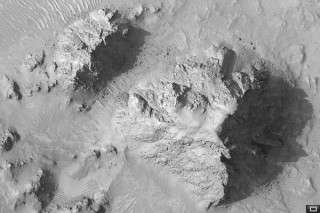This is a portion of the HiRISE image that shows the central uplift structure in Mojave Crater. Central uplifts are a typical feature of large impact craters on the Earth, the moon and Mars; craters larger than 6 or 7 kilometers in diameter on Mars typically form this mountain-like peak in the central portion of the crater interior. (Photo credit: NASA/JPL/University of Arizona)
The HiRISE camera on NASA's Mars Reconnaissance Orbiter took a huge, detailed image of Mars' Mojave crater on Jan. 7, 2007.
This is only part of that photograph. It shows the central uplift structure in the crater. Rocks that form this peak were several kilometers beneath the surface until an impact formed the 37 mile-diameter (60 kilometer) crater just north of Mars' equator. The HiRISE image shows that boulders as large as 50 feet across (15 meters) have eroded from the massive uplifted rock and rolled downslope.
The HiRISE image also confirms earlier evidence that this part of Mojave crater appears untouched by liquid water. Previous photographs taken by the HiRISE camera, and even earlier by the Mars Orbital Camera that flew on NASA'S Mars Global Surveyor, show that Mojave crater rim walls feature striking drainage channels and alluvial fans that likely were formed by surface water runoff. How runoff formed these channels and alluvial fans is one of the questions that HiRISE team members and their collaborators are looking into.
The High Resolution Science Imaging Experiment (HiRISE) team, led by University of Arizona Professor Alfred S. McEwen, is based at UA's Lunar and Planetary Laboratory in Tucson. HiRISE began the science phase of the mission in November, 2006, and posts new images and captions on the Internet at hirise.lpl.arizona.edu every Wednesday.
Source: University of Arizona
























